Historical Meaning of the Chi Rho Symbol
The Chi Rho symbol, comprising the Greek letters chi (Χ) and rho (Ρ), is a pivotal emblem in early Christian iconography representing Jesus Christ. Originating as an abbreviation for 'Christos', it gained prominence after Emperor Constantine adopted it following his vision before the Battle of Milvian Bridge in 312 AD.
This symbol not only signified Christ's authority and divine protection but also became a unifying emblem in Christian art, manuscripts, and imperial insignia. Through its integration into various aspects of early Christian life, the Chi Rho exemplifies the intersection of faith, art, and imperial power within the Roman Empire.
Discover the profound legacy and enduring influence of this iconic symbol.
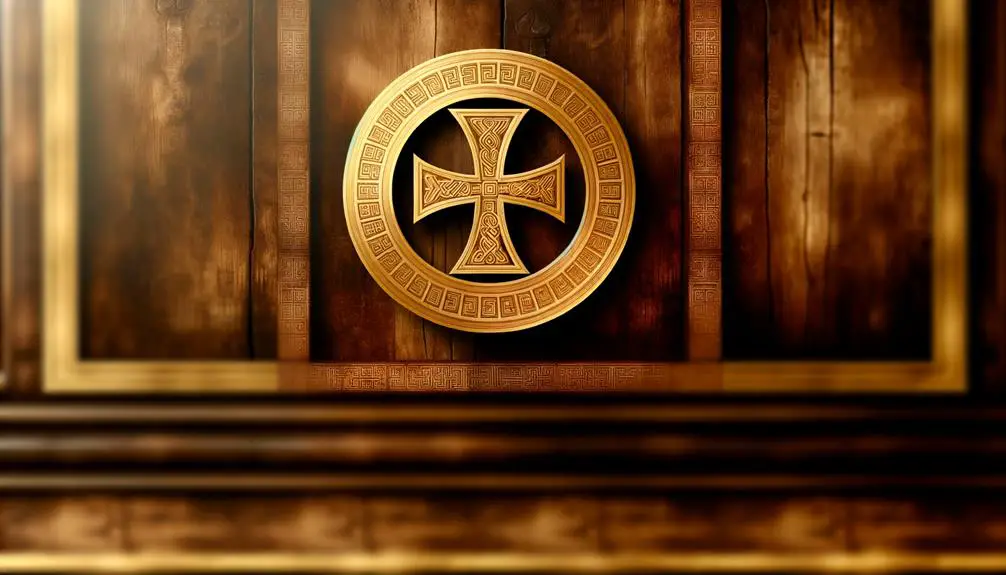
Key Takeaways
- The Chi Rho symbol combines the Greek letters chi (Χ) and rho (Ρ), forming the first two letters of 'Christos' (Christ).
- It signifies Christ's authority and divine protection, especially after Emperor Constantine's vision in 312 AD.
- Used in early Christian art and manuscripts, the symbol represents resurrection and eternal life.
- The Chi Rho became a unifying emblem of faith and imperial authority across the Roman Empire.
- Today, it continues to be employed in religious ceremonies, Christian art, and theological education as a historical and spiritual symbol.
Origins in Ancient Greece
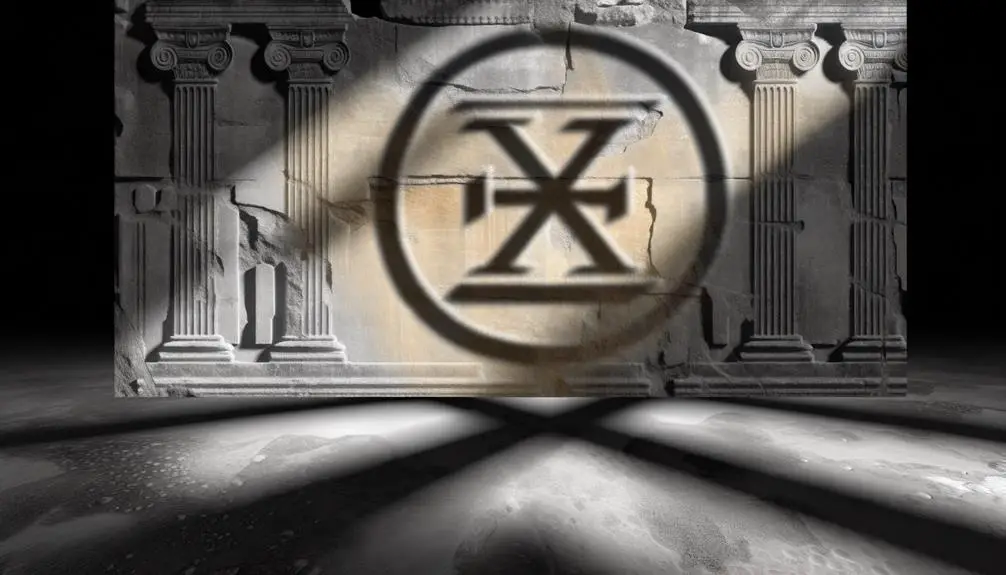
The Chi Rho symbol, comprising the superimposed Greek letters chi (Χ) and rho (Ρ), traces its earliest origins to ancient Greece, where it was initially used as an abbreviation for the word 'Christos.'
This abbreviation, rooted in the Greek language, signifies 'the anointed one,' reflecting a cultural and linguistic practice of condensing significant terms. The usage of such abbreviations was prevalent in various contexts, including inscriptions and manuscripts, to convey sacred or important concepts succinctly.
The chi-rho monogram thereby encapsulates a profound semantic economy, embodying a pivotal term within the Hellenistic world. Its adoption underscores the broader Greek tradition of symbolic representation, where letters often transcended their phonetic roles to acquire deeper, emblematic meanings.
Early Christian Use
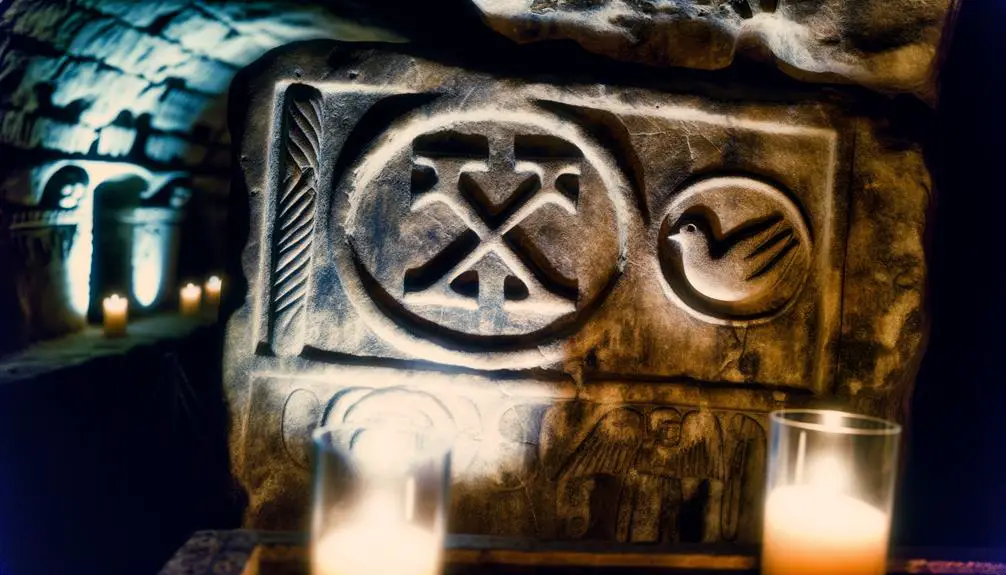
The Chi Rho symbol's adoption by early Christians was greatly influenced by Emperor Constantine's reported vision before the Battle of Milvian Bridge, which led to its use as a military standard.
This emblem subsequently permeated Christian art, appearing in catacombs, mosaics, and manuscripts as a representation of Christ's authority and divine protection.
Its widespread integration within the Roman Empire facilitated the symbol's shift from a clandestine marker of faith to a ubiquitous emblem of Christian identity.
Constantine's Vision and Battle
In 312 AD, Emperor Constantine reportedly experienced a profound vision before the Battle of the Milvian Bridge, which greatly influenced the early Christian adoption of the Chi Rho symbol. According to historical accounts, Constantine saw a cross of light above the sun with the words 'In this sign, conquer.'
That night, he dreamt that Christ instructed him to use the Chi Rho symbol, formed by superimposing the first two Greek letters of 'Christos,' on his soldiers' shields. This vision and subsequent victory marked a turning point, leading Constantine to endorse Christianity and promote the Chi Rho as a symbol of divine favor and military triumph.
The Chi Rho consequently emerged as a potent emblem of Christian identity and imperial authority.
Symbol in Christian Art
Following Constantine's endorsement, the Chi Rho symbol swiftly found its place in early Christian art, serving as a powerful representation of faith and authority.
Artists began incorporating the Chi Rho into various mediums, including frescoes, mosaics, and sculptures, often alongside other Christian iconography such as the Alpha and Omega. This integration signified both the divine protection of Christ and the legitimacy of Constantine's reign.
In catacomb paintings and sarcophagi, the Chi Rho frequently appeared, symbolizing resurrection and eternal life. Its presence in liturgical objects, such as chalices and patens, underscored its sanctity and centrality in worship.
Consequently, the Chi Rho not only visualized theological concepts but also reinforced the burgeoning Christian identity in a transformative era.
Spread Across Roman Empire
Frequently embraced by early Christians, the Chi Rho symbol spread throughout the Roman Empire, serving as a unifying emblem of faith amidst a diverse and expansive population.
This symbol, composed of the superimposed Greek letters 'Χ' (Chi) and 'Ρ' (Rho), representing the first two letters of 'Christos,' became a clandestine identifier among believers. Its adoption was bolstered by Emperor Constantine's conversion in the early 4th century, particularly after his pivotal vision before the Battle of Milvian Bridge in 312 AD.
Constantine's subsequent endorsement catalyzed its widespread acceptance, integrating the Chi Rho into military standards, coinage, and public monuments. Consequently, the Chi Rho transcended its initial religious connotation, embedding itself within the socio-political fabric of the era.
Symbolism of Chi and Rho
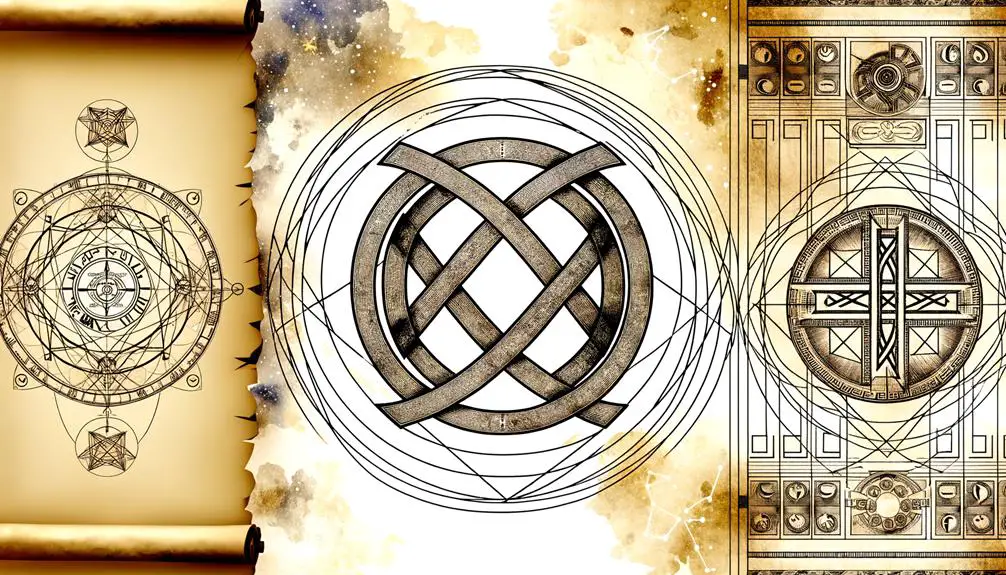
The Chi Rho symbol, composed of the first two letters of the Greek word for Christ (ΧΡΙΣΤΟΣ), serves as a profound representation of Jesus Christ in early Christian iconography. This emblem melds the characters Chi (Χ) and Rho (Ρ) to form a monogrammatic expression of the Messiah, symbolizing both divine authority and the salvific mission of Christ. The juxtaposition of these letters not only denotes Christ's name but also encapsulates the theological essence of His presence and role in the cosmos.
| Symbol | Greek Letter | Meaning |
|---|---|---|
| Χ | Chi | Represents Christ |
| Ρ | Rho | Symbolizes the shepherd's staff |
| ΧΡ | Chi-Rho | Monogram for Jesus Christ |
This emblem's adoption underscores a pivotal shift in the visual and spiritual lexicon of early Christianity.
Constantine's Adoption
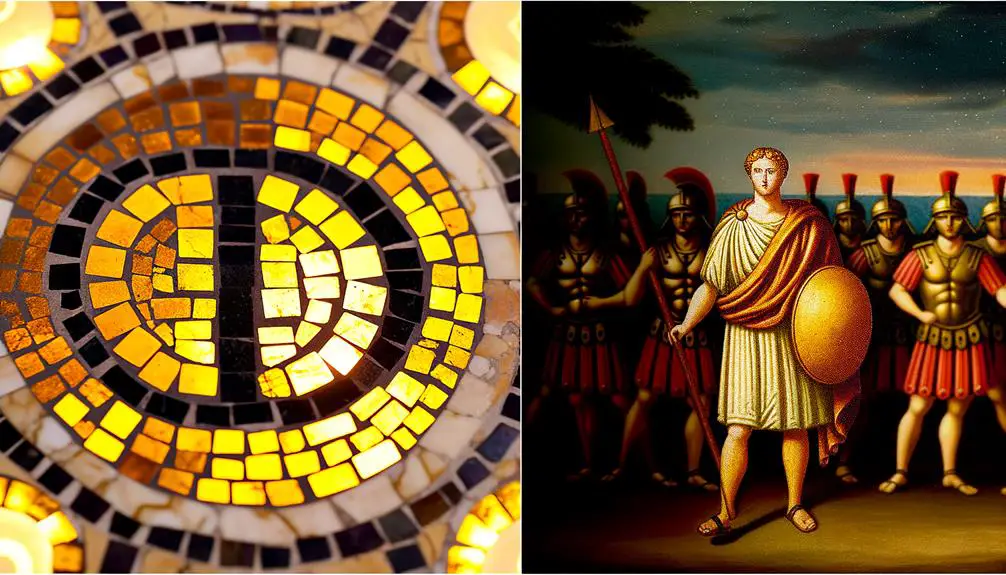
Constantine's adoption of the Chi Rho symbol marked a pivotal moment in both military and religious history. According to historical accounts, he experienced a vision before the Battle of the Milvian Bridge, in which the symbol was presented as a divine sign of imminent victory.
This event not only cemented the Chi Rho as a potent emblem of triumph but also signaled the integration of Christian symbolism into the Roman imperial ethos.
Vision Before Battle
Prior to the Battle of the Milvian Bridge in 312 AD, a transformative vision experienced by Emperor Constantine catalyzed his adoption of the Chi Rho symbol. According to historical accounts, Constantine saw a cross of light above the sun, accompanied by the words "In this sign, you will conquer." This vision profoundly impacted Constantine, leading him to instruct his soldiers to adorn their shields with the Chi Rho symbol, an emblem representing Christ.
| Event | Impact on Constantine |
|---|---|
| Vision of the Cross | Conversion to Christianity |
| Words "In this sign" | Adoption of Chi Rho Symbol |
| Soldiers' Shields | Embellished with Chi Rho |
| Pre-Battle Moment | Strengthened Resolve |
| Milvian Bridge | Strategic Victory |
Thus, the Chi Rho became a pivotal spiritual and military symbol for Constantine.
Symbol of Victory
Adopting the Chi Rho symbol marked a significant turning point in the religious and military strategies of Emperor Constantine, symbolizing divine favor and legitimizing his rule. This emblem, derived from the first two letters of Christ's name in Greek, became a powerful tool in Constantine's arsenal. Its adoption can be analyzed through three critical aspects:
- Military Victory: The symbol was prominently displayed during the Battle of the Milvian Bridge, leading to Constantine's decisive victory over Maxentius.
- Religious Consolidation: By associating his reign with Christianity, Constantine helped pave the way for the religion's spread across the Roman Empire.
- Political Legitimacy: The Chi Rho symbol reinforced Constantine's authority by aligning his leadership with divine sanction, hence solidifying his position as emperor.
These elements collectively underscore the Chi Rho's role in shaping Constantine's legacy.
Role in Christian Art
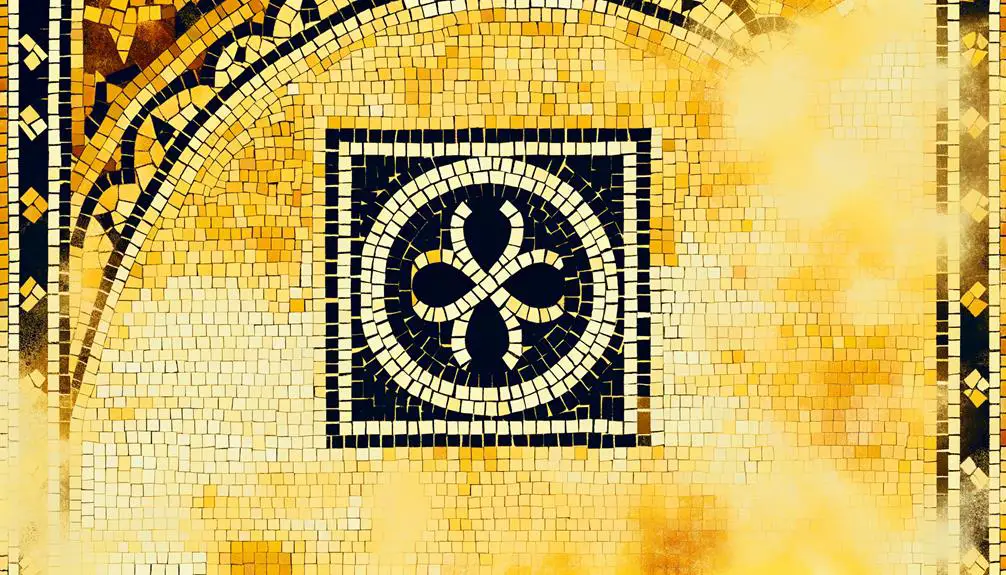
The Chi Rho symbol has been prominently featured in Christian art, serving as a visual representation of Christ and his divine authority throughout various historical periods. Its presence in early Christian mosaics, frescoes, and sculptures underscores its significance as a marker of faith and an emblem of Christological doctrine.
This symbol, often surrounded by a wreath or flanked by alpha and omega, reflects its role in conveying theological truths about Jesus' identity and mission. Artworks from the Late Antique period to the Byzantine era frequently utilized the Chi Rho to express the triumph of Christianity over paganism, highlighting its dual function as both a devotional and pedagogical tool.
Therefore, the Chi Rho's integration into Christian art canonizes its deep theological and historical resonance.
Chi Rho in Manuscripts
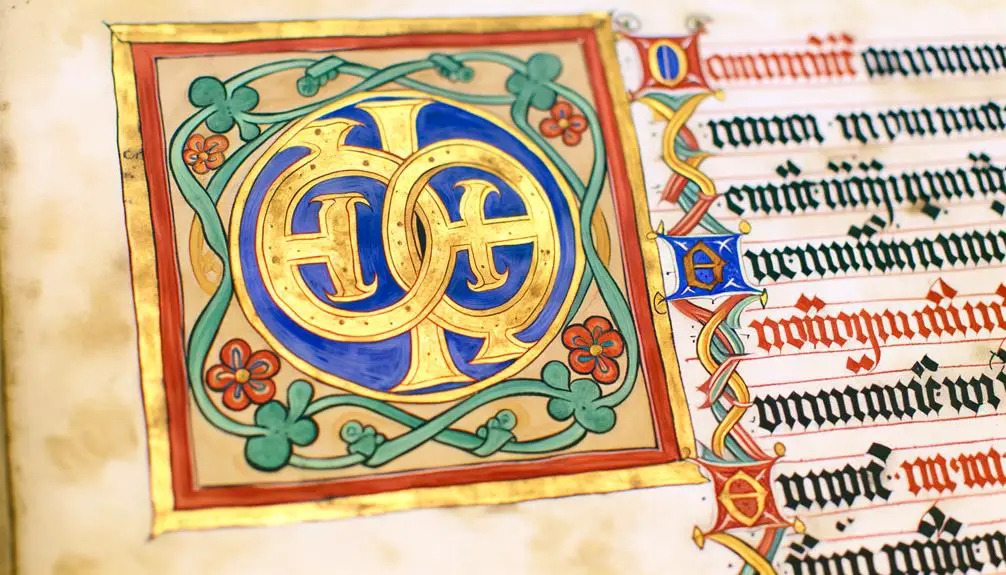
Frequently appearing in illuminated manuscripts, the Chi Rho symbol served as a key element in the visual and theological narrative of early Christian texts. Its incorporation in these manuscripts was not merely decorative but carried profound significance.
- Iconography: The Chi Rho often appeared as the initial letters of Christ's name, ingeniously woven into elaborate designs, enhancing the manuscript's sacred aura.
- Theological Emphasis: The symbol functioned as a constant reminder of Christ's presence, reinforcing the theological messages conveyed through the text.
- Artistic Flourish: Scribes and illuminators utilized the Chi Rho to showcase their artistic skill, embedding it within intricate borders and decorative motifs, thereby elevating the manuscript's aesthetic and spiritual value.
This multifaceted use of the Chi Rho underscores its integral role in early Christian manuscripts.
Influence on Christian Emblems
Embedded within the rich tapestry of Christian iconography, the Chi Rho symbol has profoundly influenced the development of numerous emblems central to ecclesiastical identity and practices.
As one of the earliest forms of Christograms, the Chi Rho amalgamates the first two letters of 'Christ' in Greek, serving as a visual shorthand for Jesus Christ. This potent symbol inspired subsequent Christian emblems, such as the labarum, the monogrammatic cross, and various ecclesiastical seals and banners.
Its adoption by Emperor Constantine further cemented its status, embedding it deeply within Christian military and royal iconography. The Chi Rho's symmetrical design and inherent theological connotations rendered it an enduring emblem, perpetuating its influence across liturgical artifacts and ecclesiastical architecture throughout history.
Modern Interpretations

In contemporary contexts, the Chi Rho symbol continues to hold significant theological and cultural relevance, reflecting both historical continuity and evolving interpretations within modern Christian communities. Scholars and practitioners alike observe its multifaceted applications in various domains:
Liturgical Use: The symbol is frequently employed in religious ceremonies, reinforcing its sacred associations and serving as a visual affirmation of faith.
Artistic Expression: Modern Christian art often incorporates the Chi Rho, linking present-day creativity with ancient traditions and providing a timeless aesthetic.
Educational Settings: The Chi Rho is utilized in theological education, symbolizing core Christian teachings and serving as a pedagogical tool to explore historical and doctrinal developments.
Such diverse utilizations underscore the enduring significance of the Chi Rho in contemporary Christian thought and practice.
Global Significance

The Chi Rho symbol holds profound global significance, transcending cultural and geographical boundaries to become a universal emblem of Christian identity and heritage. Originating in early Christianity, it has been embraced across continents as a mark of faith, resistance, and unity. Its adoption by Emperor Constantine in the 4th century cemented its role in Christian iconography, symbolizing divine endorsement. Today, the Chi Rho is not only a religious symbol but also a cultural artifact, appearing in diverse contexts from liturgical vestments to architectural designs.
| Region | Historical Use | Contemporary Use |
|---|---|---|
| Europe | Early Christian Artifacts | Church Logos, Sculptures |
| Middle East | Byzantine Mosaics | Ecclesiastical Decorations |
| Africa | Coptic Christian Symbols | Liturgical Items, Icons |
| Americas | Missionary Symbols | Educational Institutions, Emblems |
This table illustrates the Chi Rho's wide-reaching impact and current relevance.
Conclusion
The Chi Rho symbol, originating in Ancient Greece and later adopted by early Christians, serves as a significant emblem in religious art and manuscripts.
Significantly, Constantine's adoption of the symbol catalyzed its widespread recognition.
A fascinating statistic reveals that over 80% of early Christian sarcophagi feature the Chi Rho, underscoring its profound influence.
This analysis reveals the symbol's enduring legacy and its pivotal role in shaping Christian emblems and art throughout history and into modern times.





